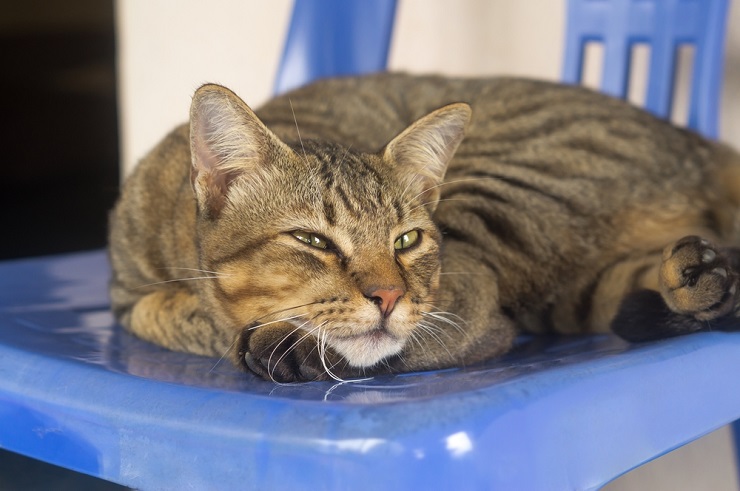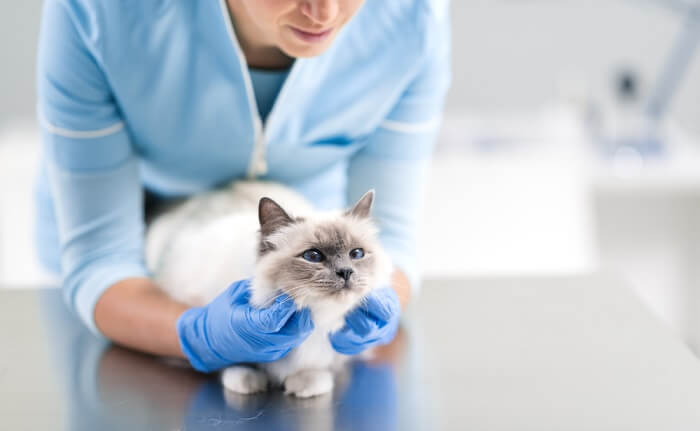How Long Does It Take For Mirtazapine To Work In Cats

Mirtazapine is a prescription appetite stimulant ordinarily used in veterinarian medicine for cats to encourage interest in food, eating, and to encourage weight gain.
Brands include Remeron and Mirataz. In this commodity, yous'll acquire what mirtazapine is, how it works, different dosage forms bachelor, potential side effects to monitor for, and some commonly asked questions.
Mirtazapine For Cats Overview

Medication Blazon:
5-HT3 (Serotonin) Receptor antagonist and tetracyclic antidepressent
Grade:
Oral tablets, topical transdermal ointment
Prescription Required?:
Yes
FDA Approved?:
On the topical transdermal ointment Mirataz is FDA canonical for use in cats.
Life Phase:
Mirataz condom studies in cats included cats as young as vii-ten months of historic period.
Brand Names:
Mirataz, Remeron
Mutual Names:
Mirtazapine
Bachelor Dosages:
Mirataz Transdermal Ointment: 100mg/tube in a 5g tube (20mg/gram); oral tablets: 7.5mg, 15mg, 30mg, and 45mg.
About Mirtazapine For Cats

Mirtazapine is classified as a serotonin receptor adversary and a tetracyclic antidepressant. However, in cats information technology is not used every bit a behavioral medication, merely more for its benefits for encouraging appetite and eating.
Norepinephrine (NE) is a neurotransmitter which, among many other roles, does act at certain receptors in the body to increment ambition. Mirtazapine is thought to cake receptors that would terminate NE'south release. This leads to an increase in NE, and a subsequent increase in ambition.
Mirtazapine also blocks serotonin receptors. By blocking sure serotonin receptors, mirtazapine also provides an antinausea and antiemetic (anti-airsickness) effect.
Currently, mirtazapine is bachelor commercially equally a generic tablet, as well as the topical transdermal brand Mirataz, which is applied to the skin of the inner surface of the ear flap.
What Does Mirtazapine Do For Cats?

Mirtazapine has been used for many years by veterinarians to aid in stimulation of ambition for cats. This may apply to cats with poor appetites, such as kitties with chronic kidney disease (CKD), or cats with other atmospheric condition causing weight loss where we desire to encourage more than calorie intake.
Side Effects Of Mirtazapine For Cats

Mirtazapine can cause hypersalivation (drooling) and sedation (excessive sleepiness) in cats.
Mirtazapine is a generally well-tolerated medication in cats, only there are some adverse effects to be aware of and monitor for.
Because mirtazapine does as well deed as a histamine blocker, sedation may be noted, especially at higher doses.
The next most common side effect is increased vocalization, seen in about 50% of cats. Agitation and gastrointestinal furnishings like vomiting may be seen in nearly 25% to 33% of cats.
Abnormal walking, restlessness/hyperactivity, and hypersalivation (drooling) may exist seen in just over 10% of cats. Remaining side effects, which impact but about 10% or less of cats, may include increased breathing and heart rate, poor appetite, disorientation, inappropriate elimination, tremors/shaking, and hiding behavior, among others.
Studies looking at mirtazapine use in cats take noted fewer agin effects when lower doses are used.
For the topical make Mirataz specifically, about x% of cats may feel reactions at the site of application on the inner surface of the ear pinna. This can include but is not limited to redness, crusting, scabbing, and balance build-up.
Of reports to the ASPCA Animal Poison Control Middle, the most common signs seen in the event of an overdose included excessive vocalizing, agitation, and vomiting. Fortunately, at least in humans, doses upwards of 10 to 30 times the prescribed dose exhibited minimal toxicity, requiring only several hours of ascertainment.
Mirtazapine can collaborate with a variety of different medications, especially sedatives, pain medications, and medications used to modify behavior. Always make sure to discuss whatsoever medications your kitty may be taking with your veterinarian if mirtazapine utilise is being recommended or prescribed.
Mirtazapine should be used carefully in pets with kidney disease, liver disease, heart disease, or diabetes mellitus. Mirtazpine is used normally with some of these atmospheric condition lending to their bear upon on appetite, but doses may need to be lower and more advisedly monitored.
If you are always concerned that your kitty may have adult side furnishings while using mirtazapine, make certain to contact your veterinary, the ASPCA Animal Poison Control Center (ane-888-426-4435), or Pet Poison Helpline (one-855-764-7661) for further communication.
Mirtazapine For Cats Dosage

Your veterinarian will recommend the platonic dosage and dosing frequency based on your cat's private needs.
The dose for the tablet course of mirtazapine may range from well-nigh ii milligrams up to 3.75 milligrams, depending on goals and tolerance of side effects. The generic tablets merely come in two sizes of 7.v milligrams and 15 milligrams.
Dosing frequency for the oral tablets may merely be required once every 48 to 72 hours, but a cat's appetite should be carefully monitored to determine the best dosing interval.
As the proper dose and frequency may depend profoundly on your cat'south needs and any current wellness atmospheric condition, always brand sure to talk over mirtazapine dosing for your kitty with your veterinarian get-go, including current and past health conditions.
The topical production Mirataz, which is a mirtazapine transdermal ointment FDA approved to manage weight loss in cats, has a labeled dose of a 1.5-inch ribbon of the ointment applied to the inner pinna (flap) of the ear once every 24 hours for fourteen days. This equates to a dose of about 2 milligrams.
With Mirataz, it is extremely important for the person applying the product to wear gloves to prevent absorption of the production on their own skin. Proper application of the product to the inner surface of the ear pinna is best done using a thumb or forefinger, just as a transdermal production, the medication could be captivated through the skin of the person applying the product.
Although mirtazapine is also a medication sometimes used in people, accidental absorption of the product should nonetheless exist avoided.
Conclusion

Mirtazapine can be a slap-up medication to help support kitties suffering from weight loss or a poor appetite. The topical brand Mirataz can also provide a welcome road of dosing a medication to a kitty already not eating well or difficult to give oral medication to.
Mirtazapine can exhibit some side effects due to its activity as an antidepressant. Even so, in a bulk of cats, especially those given lower doses, mirtazapine is oftentimes well-tolerated and a very useful therapeutic medication.
Oft Asked Questions
What does mirtazapine exercise for cats?
Mirtazapine is a type of ambition stimulant medication. It is most often used in cats suffering from a short-term or long-term decrease in appetite, also as weight loss.
How long does mirtazapine terminal in cats?
This mostly depends on the dose and form. An oral tablet dose may last on average for nigh 48 hours, though in some cats it may last for less fourth dimension and closer to 24 hours, while for others it may last up to 72 hours.
Does mirtazapine make cats sleepy?
Because one of mirtazapine'southward deportment is to act as a histamine blocker, it can lead to sedative effects. This is a like upshot as other medications we think of more as antihistamines for allergies, similar Benadryl. This outcome of mirtazapine is oftentimes seen more when higher doses are used, such as doses closer to 3.75 milligrams or higher.
How much mirtazapine can y'all give a cat?
The labeled dose for the topical product Mirataz is a 1.five-inch ribbon of ointment practical to the skin of the inner pinna (flap) of the ear. This dose equates to 2 milligrams of medication.
The mirtazapine tablet doses may range from nigh ii milligrams upwards to 3.75 milligrams commonly in cats, anywhere from every 24 to every 72 hours. Which dose is appropriate for your cat depends greatly on the condition causing poor appetite and/or weight loss, and other weather condition your kitty may accept.
Higher doses and increased frequency can be associated with more than side effects, so it's ever extremely of import to discuss dosing and frequency of mirtazapine with your vet prior to giving a dose to your cat.
Source: https://allaboutcats.com/mirtazapine-for-cats
Posted by: vogelsaind1971.blogspot.com

0 Response to "How Long Does It Take For Mirtazapine To Work In Cats"
Post a Comment